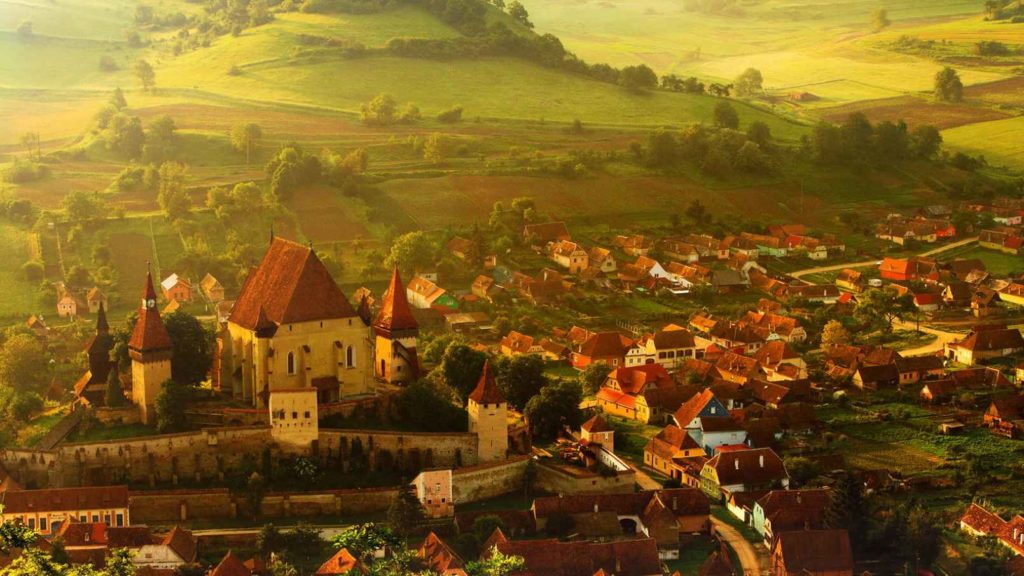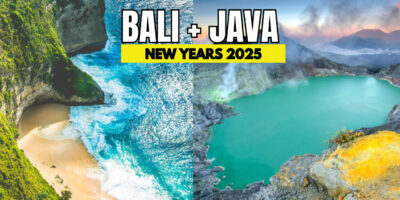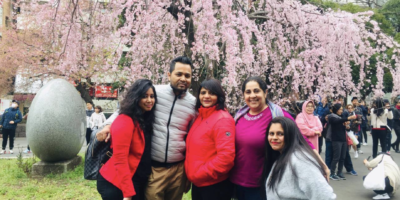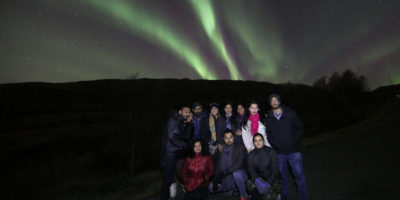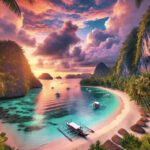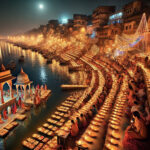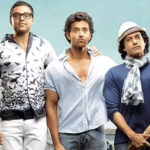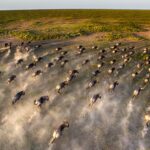R O M A N IA
Being one of the most underrated travel destinations in Europe, Romania is full of surprises for those willing to take the time and uncover everything that the country has to offer. Romania is the ideal travel destination for all kinds of tourists, from those interested in active travel (trekking tours, hiking and exploring the Carpathian Mountains) to the ones that are keen on visiting artsy or cultural attractions scattered all around the country. Each region is different, has its own “character” and some of the most interesting landmarks in this part of Europe., notably clifftop Bran Castle, long associated with the Dracula legend. Bucharest, the country’s capital, is the site of the gigantic, Communist-era Palatul Parlamentului government building.
We will be doing Romania In & Out, a road trip for 7 days. All the following routes will be done.
Weather:
Average Weather in September in Bucharest Romania. Daily high temperatures decrease by 10°F, from 81°F to 70°F (21 degree), rarely falling below 59°F(15 degree) or exceeding 90°F.
Is Romania Safe:
Europe is safe and Romania is a very safe country. It is ranked 30th out of 162 on the ranking of the safest and most dangerous countries.
How long is this road trip:
Day1 : Land in Bucharest
Day2 :Travel to Sinaia
Day3 : Brasov
Day4 :Brasov
Day5 :Sighisoara
Day6 : Sibiu
Day7 :Balea Lake
Day8 :Bucharest
Day9 :Fly back
Optional
Day 9 :Bulgaria
Day 10:Bulgaria
Day 11:Bulgaria
Day 12:Budapest
Day 13 :Budapest
Day 14 :Budapest
Day 15 :Fly Back
Dates: 30 -07 (30 Aug – 07 Sep)
Day 1 (BUCHAREST)

Known for its wide, tree-lined boulevards, glorious Belle Époque buildings and a reputation for the high life (which in the 1900s earned its nickname of “Little Paris”), Bucharest, Romania’s largest city and capital, is today a bustling metropolis.
Romanian legend has it that the city of Bucharest was founded on the banks of the Dambovita River by a shepherd named Bucur, whose name literarily means “joy.” His flute playing reportedly dazzled the people and his hearty wine from nearby vineyards endeared him to the local traders, who gave his name to the place.
Old Town, Bucharest / Centru Vechi

Probably the youngest Old Town in the world, Bucharest Old Town is a mere three years old! The aim of the redevelopment of Centru Vechi (the Old Centre, as the locals call it) was to entice locals and tourists alike to enjoy some social drinking while spending a bit of coin. The plan has been successful, this area if jumping!
Arcul de Trium
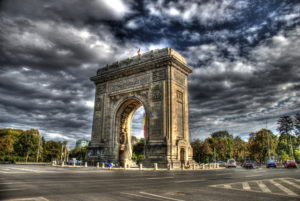
Pura Vida Sky Bar
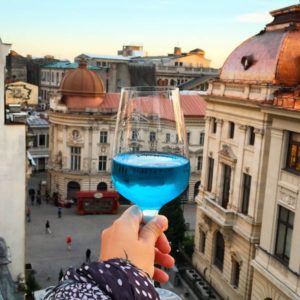
Watch the sun set over the copper rooftops with soothing summer tunes and a drink in hand at Pura Vida Sky Bar. As the Costa Rican saying goes this is a ‘pure life’!
What to do in Bucharest at night
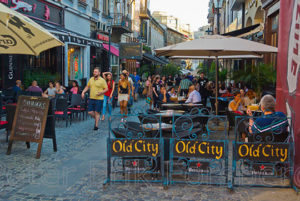 What comes after the Old Town bars? The Hipster pubs. Checking out the local talent in Bucharest will put your backpacking attire to shame. There are a lot of cool cats roaming the city streets and hanging out in Bucharest’s hipster bars. Partying is one of the more obvious things to do at night in Bucharest!
What comes after the Old Town bars? The Hipster pubs. Checking out the local talent in Bucharest will put your backpacking attire to shame. There are a lot of cool cats roaming the city streets and hanging out in Bucharest’s hipster bars. Partying is one of the more obvious things to do at night in Bucharest!
Day 2 Sinaia (128km/2 hrs)
Sinaia is a town in central Romania’s Bucegi Mountains, surrounded by ski trails. Its 17th-century Sinaia Monastery was once a royal family residence. German neo-Renaissance Peleș Castle, now a museum, has Klimt frescoes and stained-glass windows. The smaller, neighboring Pelișor Castle has a half-timbered facade. Across the Prahova River, the George Enescu Memorial House is the former home of the Romanian musician.
Babele or the Old Ladies(Bucegi Mountains)
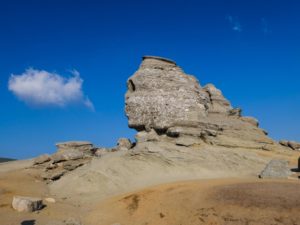 Yes, you read correctly. The Old Ladies and the Sphinx! Yes, in Romania. At 2292 meters altitude, in fact.Legends abound regarding how these rock formations came to be. They look like they just sprouted from the otherwise flat plateau. They are natural monuments, a witness to erosion, and maybe to human intervention. Yet, no one knows for sure. They have stood tall just as they do today for as far as anyone can remember.Babele or the Old Ladies is the name given to a group of these rocks. Perhaps from a certain angle they look like old ladies hunched over. Or perhaps their name is a testament to the fact that they are ancient. And timeless. Then there’s the so-called Sphinx. Not identical to the Egyptian monument, but it’s not difficult to see why it has received this imposing title.
Yes, you read correctly. The Old Ladies and the Sphinx! Yes, in Romania. At 2292 meters altitude, in fact.Legends abound regarding how these rock formations came to be. They look like they just sprouted from the otherwise flat plateau. They are natural monuments, a witness to erosion, and maybe to human intervention. Yet, no one knows for sure. They have stood tall just as they do today for as far as anyone can remember.Babele or the Old Ladies is the name given to a group of these rocks. Perhaps from a certain angle they look like old ladies hunched over. Or perhaps their name is a testament to the fact that they are ancient. And timeless. Then there’s the so-called Sphinx. Not identical to the Egyptian monument, but it’s not difficult to see why it has received this imposing title.
Peles Castle
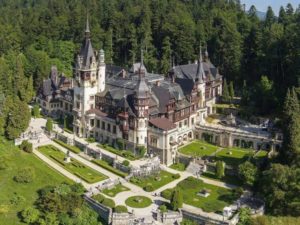 Peleș Castle is a Neo-Renaissance castle in the Carpathian Mountains, near Sinaia, in Prahova County, Romania, on an existing medieval route linking Transylvania and Wallachia, built between 1873 and 1914. Its inauguration was held in 1883. It was constructed for King Carol I.
Peleș Castle is a Neo-Renaissance castle in the Carpathian Mountains, near Sinaia, in Prahova County, Romania, on an existing medieval route linking Transylvania and Wallachia, built between 1873 and 1914. Its inauguration was held in 1883. It was constructed for King Carol I.Sinaia Monastery
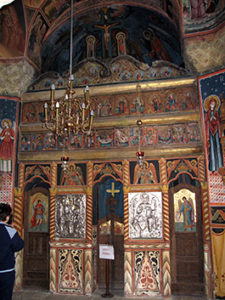
Orient Express Train station
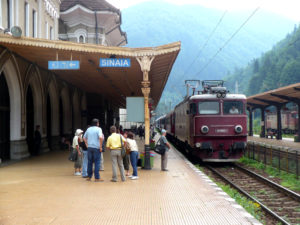
Day 3 & 4 Poiana Brasov (52km/1 hrs)
Poiana Brasov
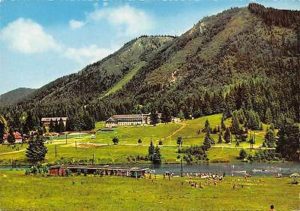
Poiana Brașov is a neighborhood of Brasov and a Romanian ski resort popular among visitors from many European states. After the 2010s modernization, the ski area has expanded from 50 hectares to 80 hectares and the slopes length was increased from 13.8 km to 23.9 km. most slopes now have snow cannons installed.
Rasnov Fortress (10km)
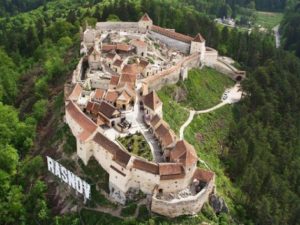
Râșnov Fortress is a historic monument and landmark in Romania. It is situated in Râşnov, Brașov County, in the immediate vicinity of Brașov. The fortress was built as part of a defence system for the Transylvanian villages exposed to outside invasions
Bran Castle (14 km)
 Many legends are connected with Bran Castle. It is said the castle belonged to Count Dracula (VladTepes), but nobody has any proof. Vlad Tepes lived only for a short time in the castle and only as a guest.The truth is that Bran Castle conjures up the perfect Gothic fairy-tale image of a Transylvanian castle and as a result it draws crowds of tourists from far and wide. In 1897 Bram Stoker wrote a terrifying story about Count Dracula. A century after, there are still people who believe in it. Even researchers are trying to find out the truth about Dracula. All are trying to clear the mystery: was there or wasn’t there a vampire in Transylvania? Stoker’s story is based on the life of Vlad Tepes/Vlad the Impaler (1431-1476), a ruler revered by Romanians for standing up to the Ottoman Empire. Known as one of the most dreadful enemies of the Turks, Vlad started organizing the state and enforcing the law by applying death penalty and impaling all those he considered enemies: robbers, cunning priests, treacherous noblemen, beggars, usurper Saxons. The historians nicknamed him Vlad Tepes while people say he was Count Dracula because he used to sign with his father’s name, Dracul “The Devil”. Dracula is derived from the Romanian word for devil or dragon. His castle is supposed to be Bran’s Castle since its narrow corridors constitute a mysterious labyrinth of ghostly nooks and secret chambers easy to hide a “vampire”.The Dracula’s Castle was built on the edge of the Bran Pass and nowadays lures guests worldwide who wish to partake in the legend of the Count Dracula.
Many legends are connected with Bran Castle. It is said the castle belonged to Count Dracula (VladTepes), but nobody has any proof. Vlad Tepes lived only for a short time in the castle and only as a guest.The truth is that Bran Castle conjures up the perfect Gothic fairy-tale image of a Transylvanian castle and as a result it draws crowds of tourists from far and wide. In 1897 Bram Stoker wrote a terrifying story about Count Dracula. A century after, there are still people who believe in it. Even researchers are trying to find out the truth about Dracula. All are trying to clear the mystery: was there or wasn’t there a vampire in Transylvania? Stoker’s story is based on the life of Vlad Tepes/Vlad the Impaler (1431-1476), a ruler revered by Romanians for standing up to the Ottoman Empire. Known as one of the most dreadful enemies of the Turks, Vlad started organizing the state and enforcing the law by applying death penalty and impaling all those he considered enemies: robbers, cunning priests, treacherous noblemen, beggars, usurper Saxons. The historians nicknamed him Vlad Tepes while people say he was Count Dracula because he used to sign with his father’s name, Dracul “The Devil”. Dracula is derived from the Romanian word for devil or dragon. His castle is supposed to be Bran’s Castle since its narrow corridors constitute a mysterious labyrinth of ghostly nooks and secret chambers easy to hide a “vampire”.The Dracula’s Castle was built on the edge of the Bran Pass and nowadays lures guests worldwide who wish to partake in the legend of the Count Dracula.
Black church
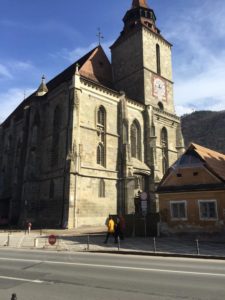 The dimensions of the Black Church from Brasov are monumental, it’s 90 meters long, 25 to 37 meters wide, 65 meters tall, with a capacity of receiving up to 5,000 people and walls 21 meters high. Initially named Saint Mary’s Church after the patron saint of Brasov, the church was built starting with the 14th century on the location of an older and smaller religious edifice.
The dimensions of the Black Church from Brasov are monumental, it’s 90 meters long, 25 to 37 meters wide, 65 meters tall, with a capacity of receiving up to 5,000 people and walls 21 meters high. Initially named Saint Mary’s Church after the patron saint of Brasov, the church was built starting with the 14th century on the location of an older and smaller religious edifice.
The magnitude of the church’s dimension was meant to impress worshipers and gain new adepts for the Catholic Church that reached in Transylvania its Eastern border.
Old city centre
Strada Sforii (Rope street)
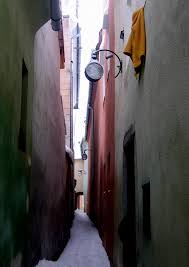 Strada Sforii—which translates roughly as “Rope Street”—was built in the 15th century to afford fire fighting brigades passage between the major thoroughfares at either end. Given its close proximity to Brașov’s main square, Piața Sfatului, and the historically significant Gothic Lutheran church Biserica Neagră (“Black Church”) found therein, Strada Sforii has gone from an urban planning hack to a popular tourist attraction.
Strada Sforii—which translates roughly as “Rope Street”—was built in the 15th century to afford fire fighting brigades passage between the major thoroughfares at either end. Given its close proximity to Brașov’s main square, Piața Sfatului, and the historically significant Gothic Lutheran church Biserica Neagră (“Black Church”) found therein, Strada Sforii has gone from an urban planning hack to a popular tourist attraction.
Measuring 80 meters (260 feet) long and varying in width from 111-135 centimeters (44-53 inches), Strada Sforii is the third-narrowest street in Europe, after Spreuerhofstraße in Reutlingen, Germany (recognized by Guinness as the narrowest street in the world) and Parliament Street in Exeter, England. At its narrowest point, visitors can touch both walls on either side of the street.
Viscri (14km)
Village of Viscri
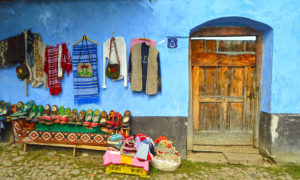 Viscri is the well preserved Romanian village where you can have a feel of real Romania.And maybe the fact that the village doesn’t have a paved street and is far from the main road helps to preserve its authentic view of a Saxon village from the Middle Ages.The most interesting fact about the Transylvanian village is that HRH Prince Charles himself has a B&B in Viscri. It is a well preserved and authentic furnished blue Saxon-Transylvanian house. You can have a great stay in this beautiful house.
Viscri is the well preserved Romanian village where you can have a feel of real Romania.And maybe the fact that the village doesn’t have a paved street and is far from the main road helps to preserve its authentic view of a Saxon village from the Middle Ages.The most interesting fact about the Transylvanian village is that HRH Prince Charles himself has a B&B in Viscri. It is a well preserved and authentic furnished blue Saxon-Transylvanian house. You can have a great stay in this beautiful house.
The fortified church
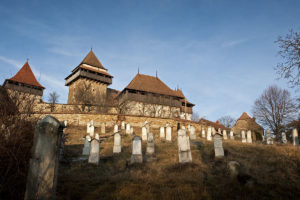 All these amazing old buildings and the village itself are in the list of World Heritage Sites of UNESCO (1999). The first buildings were erected in 12th century when the Saxons settled the area.
All these amazing old buildings and the village itself are in the list of World Heritage Sites of UNESCO (1999). The first buildings were erected in 12th century when the Saxons settled the area.
Over the years the church had undergone many transformations and reconstructions. In the middle ages the walls were strengthened. The current look of the complex is perhaps due to the XVIII century’s renovations.
Day 5 (130km/2 hrs)
Sighisoara
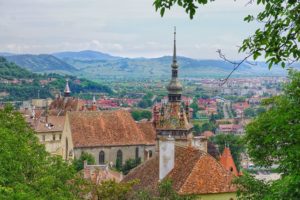 Sighișoara is a city on the Târnava Mare River in Mureș County, Romania. Located in the historic region of Transylvania, Sighișoara has a population of 28,102 according to the 2011 census. It is a popular tourist destination for its well-preserved walled old town, which is listed by UNESCO as a World Heritage Site.
Sighișoara is a city on the Târnava Mare River in Mureș County, Romania. Located in the historic region of Transylvania, Sighișoara has a population of 28,102 according to the 2011 census. It is a popular tourist destination for its well-preserved walled old town, which is listed by UNESCO as a World Heritage Site.Sighisoara Citadel
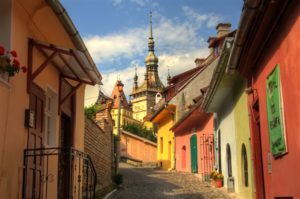
Covered staircase
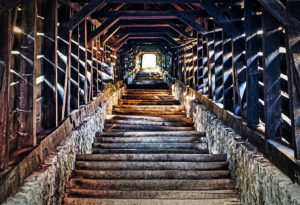 Located at the end of School Street and connecting the Citadel Square with
Located at the end of School Street and connecting the Citadel Square with
the Church on the Hill, the Scholars’ Stairs, or Schoolboys’ Stairs, as it was also known, makes for an interesting piece of medieval architecture.
Built in 1642, the covered stair-passage was meant to facilitate and protect schoolchildren and churchgoers on their climb to the school and church during wintertime. Originally, the stairs had 300 steps, but after 1849, their number
was reduced to 175.
Vlad The Impaler’s birth house (so Dracula birth house)
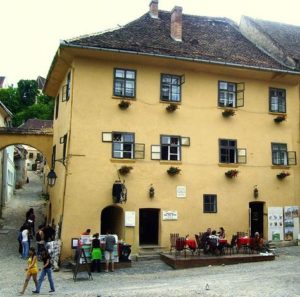 The ancient house of the Vlad Dracul family is situated on the Council tower square in what after the assumptions the dreadful Vlad Tepes born. The son of an ancient imperator of Tara Romaneasca was well-known for his cruel executions through what he disposed of his enemies. From this born the world-wild known legend of Dracula.Vlad Tepes so called Dracula probably borned in this house in 1431 and supposedly he also lived here until the age of four as his father lived between 1431-1436 in the castle-town. Actually in the house functions a bar and a restaurant.
The ancient house of the Vlad Dracul family is situated on the Council tower square in what after the assumptions the dreadful Vlad Tepes born. The son of an ancient imperator of Tara Romaneasca was well-known for his cruel executions through what he disposed of his enemies. From this born the world-wild known legend of Dracula.Vlad Tepes so called Dracula probably borned in this house in 1431 and supposedly he also lived here until the age of four as his father lived between 1431-1436 in the castle-town. Actually in the house functions a bar and a restaurant.
Day 6 Sibiu (105/1:45 hrs)
Sibiu :The Beating Heart Of Romania (90km)
Orthodox Cathedral
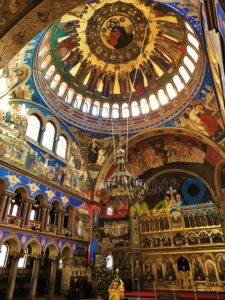 Built between 1902 and 1906, Sibiu’s enormous Orthodox Cathedral was, surprisingly, designed by two Budapest-based Hungarian architects, Virgil Nagy and Iosif Kamner. The ornate exterior (two colours of pressed stone set in horizontal stripes) is complemented by a wonderful interior, possibly the most extravagantly decorated of any church in Romania. Its centrepiece is a huge dome boasting colourful mosaics painted in Munich, although the gargantuan golden altar will not fail to catch your eye. Later additions include paintings from the 1950s by Ioan Köber and Anastase Demian, including the impressive frescoes at the altar.
Built between 1902 and 1906, Sibiu’s enormous Orthodox Cathedral was, surprisingly, designed by two Budapest-based Hungarian architects, Virgil Nagy and Iosif Kamner. The ornate exterior (two colours of pressed stone set in horizontal stripes) is complemented by a wonderful interior, possibly the most extravagantly decorated of any church in Romania. Its centrepiece is a huge dome boasting colourful mosaics painted in Munich, although the gargantuan golden altar will not fail to catch your eye. Later additions include paintings from the 1950s by Ioan Köber and Anastase Demian, including the impressive frescoes at the altar.
Piata Mica
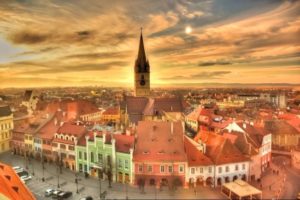 Walking through the passage underneath Turnul Sfatului, you will come to Piata Mica (The Small Square) which you will notice immediately is anything but small, and is not exactly square either. It is delightful though: much quieter, shadier and simply more peaceful than its busy neighbour. It’s home to some great cafes, restaurants and bars, as well as museums and historic houses. In the middle of the square is Strada Ocnei, the main street to the lower town, which passes under the wrought iron Podul Minciunilor (Liars’ Bridge), so called because of the ne’er-do-wells and cheating merchants who would, legend has it, gather on it.
Walking through the passage underneath Turnul Sfatului, you will come to Piata Mica (The Small Square) which you will notice immediately is anything but small, and is not exactly square either. It is delightful though: much quieter, shadier and simply more peaceful than its busy neighbour. It’s home to some great cafes, restaurants and bars, as well as museums and historic houses. In the middle of the square is Strada Ocnei, the main street to the lower town, which passes under the wrought iron Podul Minciunilor (Liars’ Bridge), so called because of the ne’er-do-wells and cheating merchants who would, legend has it, gather on it.
Other Attractions:
- Grand Square
- Council Tower
- Cross The Bridge of Lies
- Lower Town
- The passage of the stairs
- Brukenthal National Museum- Van Gough,
- Hireoymus Bosch artwork
- Sfatuli- imposing tower
Day 7 TransfagarasanRoute (78 km/2:00 hrs)
Transfagarasan Route & Balea Lake
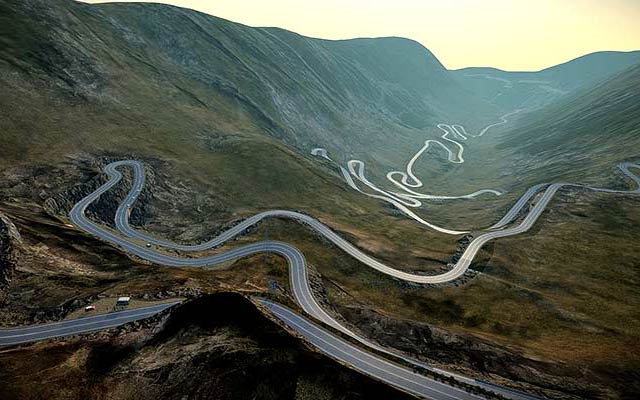
Named the “the best road in the world” by the Top Gear team in 2009, Transfagarasan has enjoyed a great popularity among the most beautiful roads in the world since.
It is the second highest road in Romania and it is known for its spectacular landscapes. This means 151 km of road curves and twists perfectly set for driving enthusiasts, but also for those who want to admire the beauty of nature in a unique location.
The road links Sibiu to Pitesti and it’s sprinkled with many switchbacks, bridges, viaducts, tunnels and a lot of sights such as Balea Waterfall, Balea Lake, Capra Lake (Goat Lake), Vidraru Dam, Vidraru Lake, Poenari Castle and so on.
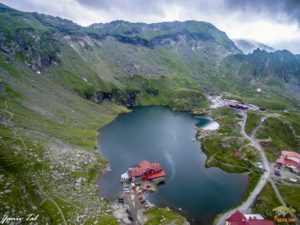 Geographically, Bâlea Lake came to be when a glacier eroded the mountains and then melted. Historically, there is a legend related to the lake’s name, whose main character is the young shepherd Balea.The story goes that one day he was herding his sheep in the mountains, near a forest. Suddenly, a bear jumped out from the trees, but Balea was brave enough to defeat him and chase him away.When the king heard of his courage, Balea was invited to be part of the king’s guards. His stay at the castle came with the love of the king’s oldest daughter. She managed to convince the shepherd to marry her, but on their wedding day, a violent storm appeared out of nowhere. Unfortunately, the two lost their lives in the storm.Touched by their story, the locals decided to name the lake after the brave shepherd
Geographically, Bâlea Lake came to be when a glacier eroded the mountains and then melted. Historically, there is a legend related to the lake’s name, whose main character is the young shepherd Balea.The story goes that one day he was herding his sheep in the mountains, near a forest. Suddenly, a bear jumped out from the trees, but Balea was brave enough to defeat him and chase him away.When the king heard of his courage, Balea was invited to be part of the king’s guards. His stay at the castle came with the love of the king’s oldest daughter. She managed to convince the shepherd to marry her, but on their wedding day, a violent storm appeared out of nowhere. Unfortunately, the two lost their lives in the storm.Touched by their story, the locals decided to name the lake after the brave shepherd
Day 8 BUCHAREST (238 km/4:00 hrs)
Day 9
Bulgaria
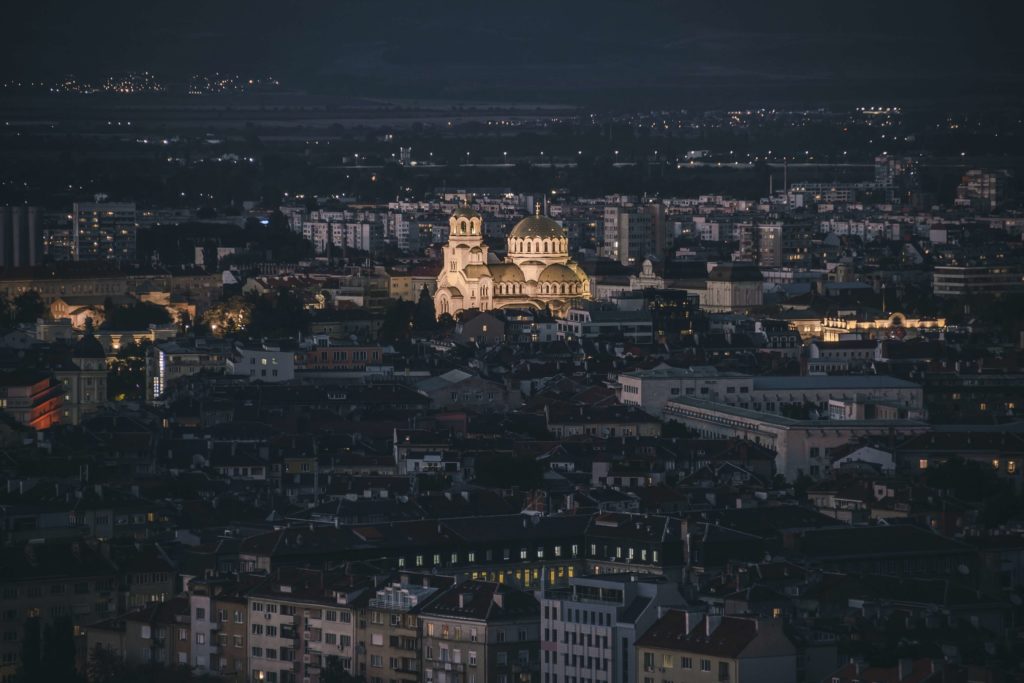
Day 9
Land in Sofia (capital) and check-in in hotel.
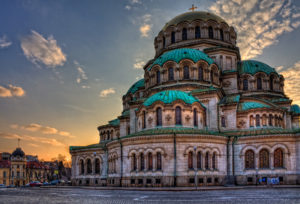 The gold-domed Alexander Nevsky Cathedral was built in the early 20th century in memory of the 200,000 Russian, Ukrainian, Belorussian and Bulgarian soldiers, who died in the Russo-Turkish War, 1877–1878. It is one of the largest Eastern Orthodox cathedrals in the world. The cathedral’s gold-plated dome is 45 m high, with the bell tower reaching 50.52 m.
The gold-domed Alexander Nevsky Cathedral was built in the early 20th century in memory of the 200,000 Russian, Ukrainian, Belorussian and Bulgarian soldiers, who died in the Russo-Turkish War, 1877–1878. It is one of the largest Eastern Orthodox cathedrals in the world. The cathedral’s gold-plated dome is 45 m high, with the bell tower reaching 50.52 m.
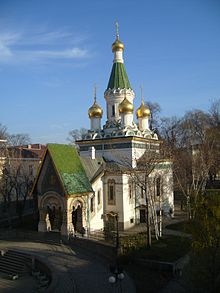
Russian Church, which is a 6-minute walk from St. Alexander Nevsky Cathedral. With gold-plated onion domes and a fairytale exterior, the Russian Church is a must-see site during your one day in Sofia. After you have a chance to admire the church’s interior, head outside and to the right. There’s a door leading to the crypt where the grave of Archbishop Seraphim Sobolev is located. The Archbishop was known as a wonderworker, and locals write him notes filled with their wishes and prayers. Paper and pencils are provided. Simply sit down, write down a wish, and place it at Seraphim Sobolev’s grave.
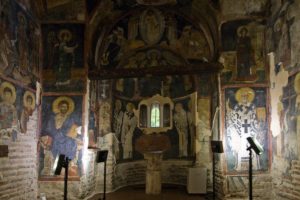
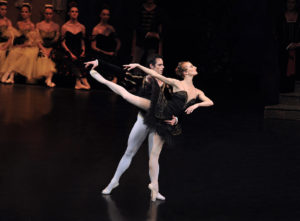 The dance troupe is primarily constituted of the foremost dancers from Eastern European ballet companies who are also our partners in the various productions and tours. Costumes and scenery are those of the Eastern European theaters or customized and tailored to a specific project.The soloists of the company are soloists of Sofia National Opera and Ballet, Bucharest National Opera and Ballet, Chisinau National Opera and Ballet, Ballet Nacional de Cuba, Norwegian National Opera and Ballet, Macedonian Opera and Ballet, etc. The repertoire performed by the Sofia Ballet hosts major classical ballets, it remains faithful to the Great Russian school and tradition through: The Nutcracker, Swan Lake, Sleeping Beauty, Giselle, Don Quixote, etc.
The dance troupe is primarily constituted of the foremost dancers from Eastern European ballet companies who are also our partners in the various productions and tours. Costumes and scenery are those of the Eastern European theaters or customized and tailored to a specific project.The soloists of the company are soloists of Sofia National Opera and Ballet, Bucharest National Opera and Ballet, Chisinau National Opera and Ballet, Ballet Nacional de Cuba, Norwegian National Opera and Ballet, Macedonian Opera and Ballet, etc. The repertoire performed by the Sofia Ballet hosts major classical ballets, it remains faithful to the Great Russian school and tradition through: The Nutcracker, Swan Lake, Sleeping Beauty, Giselle, Don Quixote, etc.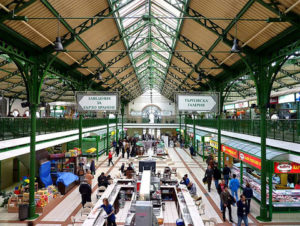 The Central Sofia Market Hall is a covered market in the center of Sofia city, on Maria Louise Blvd. also known as Halite or Tsentralni Hali. It was opened back in 1911 and today is an one of the strategic shopping locations in the city.
The Central Sofia Market Hall is a covered market in the center of Sofia city, on Maria Louise Blvd. also known as Halite or Tsentralni Hali. It was opened back in 1911 and today is an one of the strategic shopping locations in the city.
The style is Neo-Renaissance, and features elements of Neo-Byzantine as well as Neo-Baroque architecture. Interesting features on the facade include the relief of the coat of arms of Sofia above the main entrance and the famous small clock tower with three dials on top of the edifice. The building was originally constructed with 4 entrances, only 3 are used today.
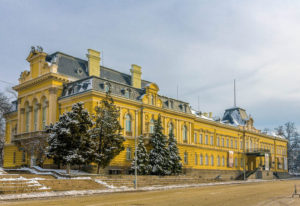 Built in 1873, it was the residence of the ruling governor during the Ottoman occupation, with administrative offices and police headquarters on the lower floors. It was in fact here that Vassil Levski was tried and sentenced to death. After liberation it became the seat of Bulgaria’s first post liberation monarch, Knyaz Alexander Battenberg and it was the first building to be refurbished in contemporary Viennese style, with Austrian architects Rumpelmaier and Gruenanger each adding new wings.
Built in 1873, it was the residence of the ruling governor during the Ottoman occupation, with administrative offices and police headquarters on the lower floors. It was in fact here that Vassil Levski was tried and sentenced to death. After liberation it became the seat of Bulgaria’s first post liberation monarch, Knyaz Alexander Battenberg and it was the first building to be refurbished in contemporary Viennese style, with Austrian architects Rumpelmaier and Gruenanger each adding new wings.It is now home to the National Art Gallery and the Ethnographic Museum and this is the only way the palace can be visited. The exterior has recently been restored to its former glory.
Day 10
Plovdiv (Day tour)
Take a morning train to Plovdiv (150km/2.30h)
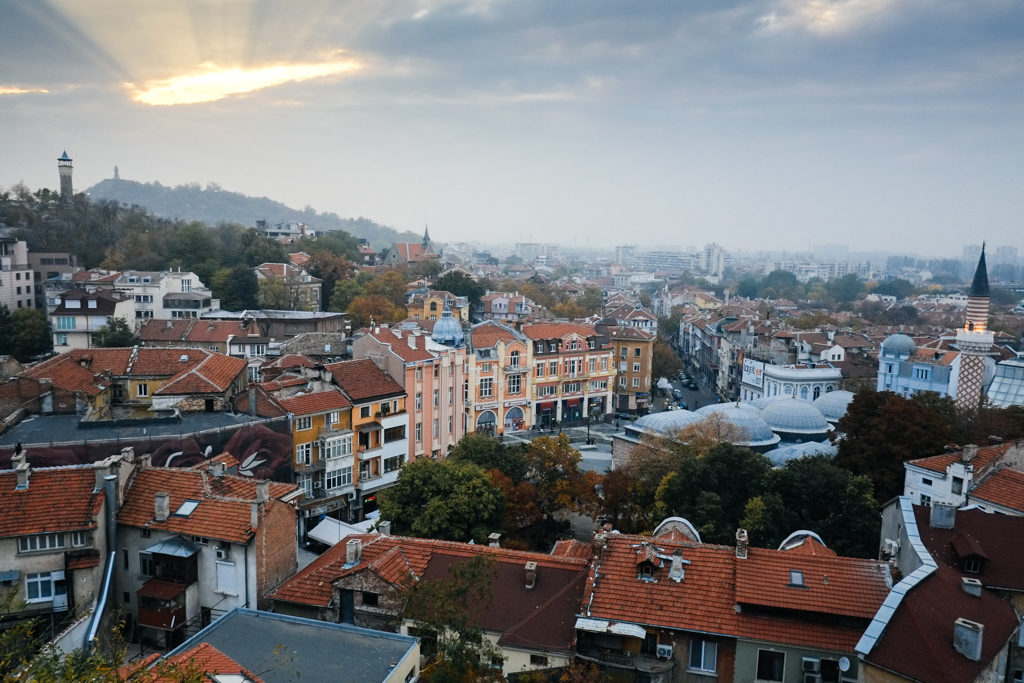
Plovdiv is an ancient city built around 7 hills, in southern Bulgaria. The Regional Archaeological Museum chronicles the city’s history, with exhibits including mosaic panels, clay lamps and early coins. The Roman-era Ancient Theatre of Philippopolis, which once seated around 6,000, now hosts opera and concerts.
Main Street
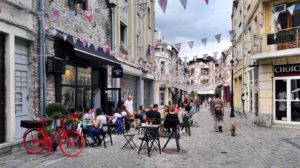 The Main Street is a pedestrian area in the center of Plovdiv. It starts from Central Square at the venue of Ramada Plovdiv Trimontium hotel. Down the Main Street are Stefan Stambolov Square with the Municipality building, the Roman Stadium and Dzhumaya mosque. Near the mosque, the street loosely bounds the Old Town and The Trap (Kapana District), which is in the close proximity of the so-called Small Main Street (Rayko Daskalov Str.). Here is the Spopping Center Hali, after which the Main Street crosses 6th September Blvd. in underpass at Maritsa Pharmacy and ends at the pedestrian bridge over Maritsa River, which marks the end of the shopping area.
The Main Street is a pedestrian area in the center of Plovdiv. It starts from Central Square at the venue of Ramada Plovdiv Trimontium hotel. Down the Main Street are Stefan Stambolov Square with the Municipality building, the Roman Stadium and Dzhumaya mosque. Near the mosque, the street loosely bounds the Old Town and The Trap (Kapana District), which is in the close proximity of the so-called Small Main Street (Rayko Daskalov Str.). Here is the Spopping Center Hali, after which the Main Street crosses 6th September Blvd. in underpass at Maritsa Pharmacy and ends at the pedestrian bridge over Maritsa River, which marks the end of the shopping area.
Ancient theater of philippopolis
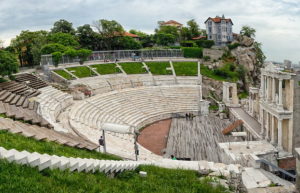
The Roman theatre of Plovdiv is one of the world’s best-preserved ancient theatres, located in the city center of Plovdiv, Bulgaria. It was constructed in the 90s of the 1st century AD, probably under the rulership of Emperor Domitian. The theatre can host between 5000 and 7000 spectators and it is currently in use.
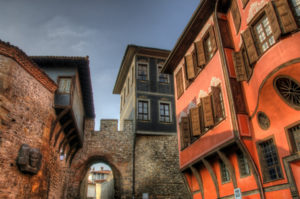 Hisar Kapia is a medieval gate in Plovdiv’s old town and one of the most famous tourist sights in the city. The gate was built in the 11th century AD over the foundations of a gate from Roman times. Hisar Kapia is one of the three entrances to the acropolis of ancient Plovdiv.
Hisar Kapia is a medieval gate in Plovdiv’s old town and one of the most famous tourist sights in the city. The gate was built in the 11th century AD over the foundations of a gate from Roman times. Hisar Kapia is one of the three entrances to the acropolis of ancient Plovdiv.
In the evening we will be back to Sofia
Day 11
Today we will do a road trip to Rila Monastery and Rila 7 lakes:
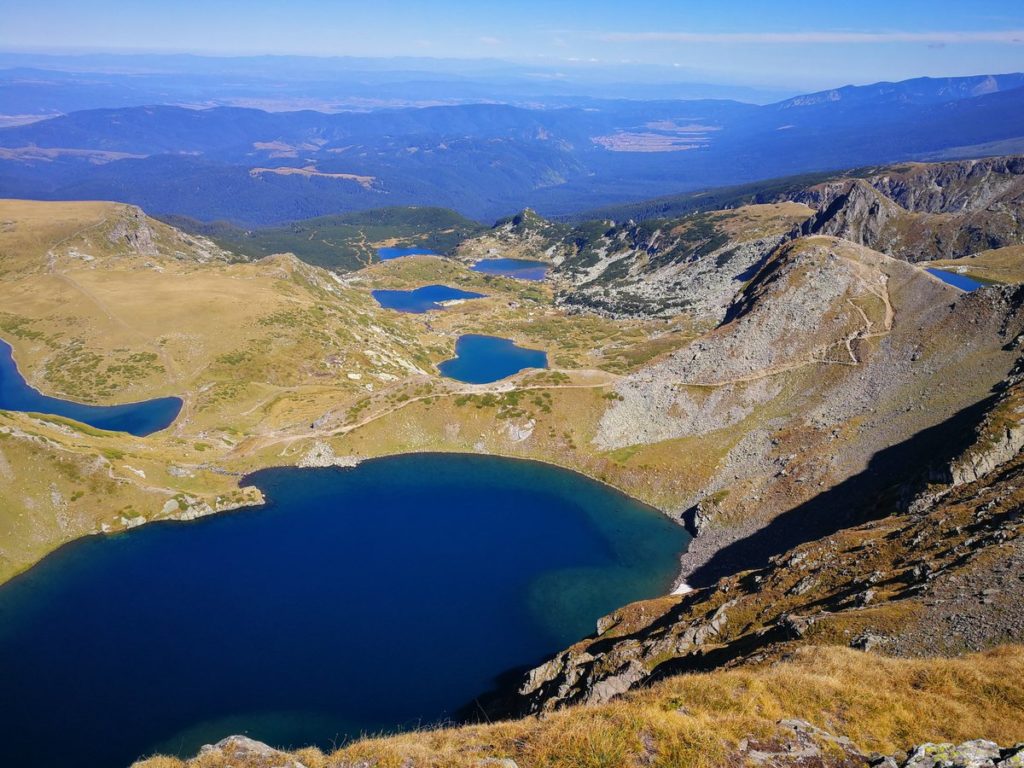 As you can probably guess, they are 7 lakes all in close proximity of each other high up in the mountains. In winter, they are frozen over and covered in snow. In summer, once melted, they are a clear emerald green and sapphire blue, and each one is incredibly beautiful.
As you can probably guess, they are 7 lakes all in close proximity of each other high up in the mountains. In winter, they are frozen over and covered in snow. In summer, once melted, they are a clear emerald green and sapphire blue, and each one is incredibly beautiful.
Each of the 7 lakes has a name so these are the ones you want to tick off:
- Salzata (The Tear) – very clear waters that really show off the colours of the lakes
- Okoto (The Eye) – this has a oval shape resembling an eye
- Babreka (The Kidney) – this has a crescent shape resembling a kidney
- Bliznaka (The Twins) – this is almost two lakes that are connected
- Trilistnika (The Trefoil) – this looks like a three-leafed clover
- Ribnoto (Fish lake) – this is the shallowest of all the lakes
- Dolnoto ezero (The Lower lake) – this is the lowest of all the lakes
Yes, it is a trek and you will love it.
Rila Monastery:
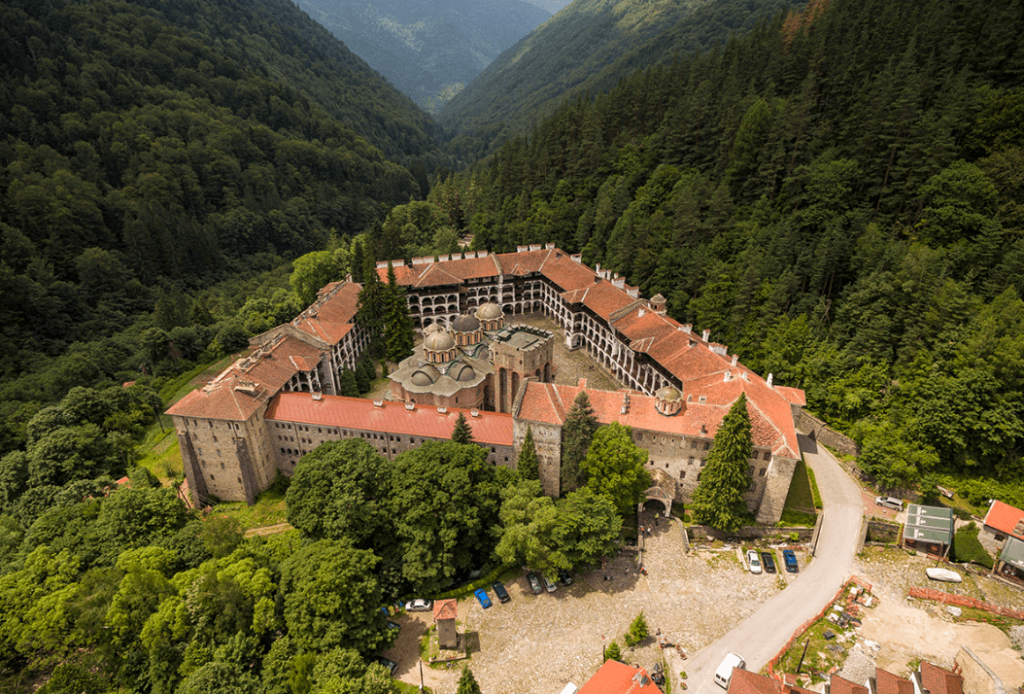
Rila Monastery was founded in the 10th century by St John of Rila, a hermit canonized by the Orthodox Church. His ascetic dwelling and tomb became a holy site and were transformed into a monastic complex which played an important role in the spiritual and social life of medieval Bulgaria. Destroyed by fire at the beginning of the 19th century, the complex was rebuilt between 1834 and 1862. A characteristic example of the Bulgarian Renaissance (18th–19th centuries), the monument symbolizes the awareness of a Slavic cultural identity following centuries of occupation.
Day 12
BUDAPEST
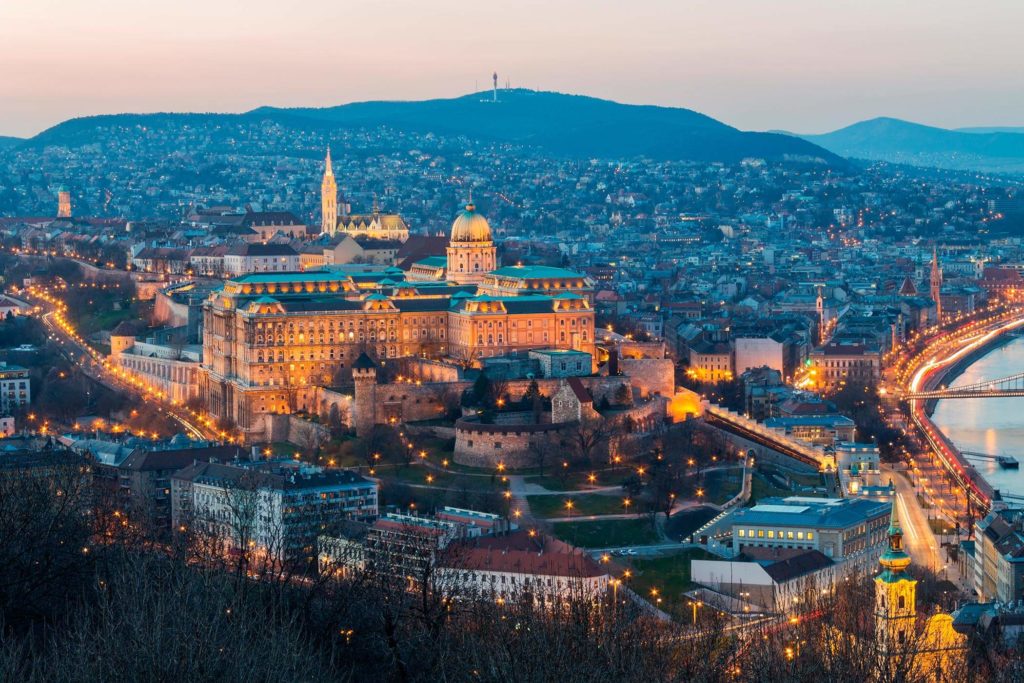
Széchenyi Baths
 Szechenyi Spa Baths is in the biggest green park of Budapest, in the City Park, close to a bunch of Budapest attractions. The Neo-baroque palace was specifically built for hosting Szechenyi Baths as Hungary has been the country of baths (and Budapest the City of Baths) for many centuries: starting with the Roman settlers who built the first spa baths, through the 16th century Turkish occupiers who built many of the famous and revived Turkish baths in Budapest to the 19-20th century natural medical trends that promote aqua therapies and their deeply beneficial effects. The beautiful building of the spa baths is the design of Gyozo Czigler (Győző Czigler) who started to build Szechenyi Furdo in May 1909.
Szechenyi Spa Baths is in the biggest green park of Budapest, in the City Park, close to a bunch of Budapest attractions. The Neo-baroque palace was specifically built for hosting Szechenyi Baths as Hungary has been the country of baths (and Budapest the City of Baths) for many centuries: starting with the Roman settlers who built the first spa baths, through the 16th century Turkish occupiers who built many of the famous and revived Turkish baths in Budapest to the 19-20th century natural medical trends that promote aqua therapies and their deeply beneficial effects. The beautiful building of the spa baths is the design of Gyozo Czigler (Győző Czigler) who started to build Szechenyi Furdo in May 1909.
Chain Bridge
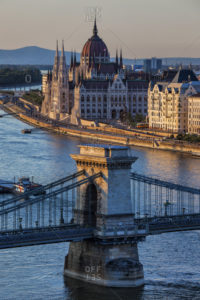
Mosque of Pasha Qasim
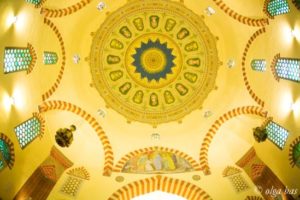 This fantastic building was originally erected in the latter half of the 16th Century whilst the country was under the control of the Ottoman Empire.
This fantastic building was originally erected in the latter half of the 16th Century whilst the country was under the control of the Ottoman Empire.
Although it was designed as a mosque (the minaret was removed from the building by Jesuits in 1766), it is now in use as a Roman Catholic Church.
It is one of the finest examples of Turkish architecture in the whole country.
Despite its current use, it is still possible to see inscriptions from the Koran in certain sections of the building.
Hungarian Parliament Building
 The Hungarian Parliament Building is an amazing example of the Gothic Revival style of architecture.
The Hungarian Parliament Building is an amazing example of the Gothic Revival style of architecture.
Sitting on the banks of the Danube, the building is currently the largest in Hungary and the tallest in Budapest.Hundreds of spires and arches sit around an impressive central dome, which looks out across a large square, where political rallies often take place.Thanks to creative lighting, the building looks even more impressive at night.
Necropolis of Sopianae
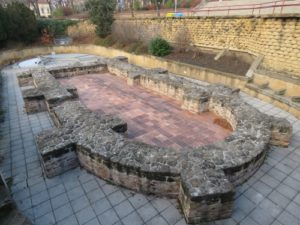 The Necropolis of Sopianae is one of Hungary’s UNESCO World Heritage Sites.
The Necropolis of Sopianae is one of Hungary’s UNESCO World Heritage Sites.
In the 4th Century, Pécs (then known as Sopianae by the Roman Empire) was an important Christian stronghold, and this Necropolis displays a mixture of Christian and Roman influences.
The painted frescos and sarcophaguses which can be seen at the site are very interesting examples of early Christian artworks.
As the city of the dead expanded, other collections of tombs sprung up around the city but these have less cultural importance than the main Christian works.
Memento Park
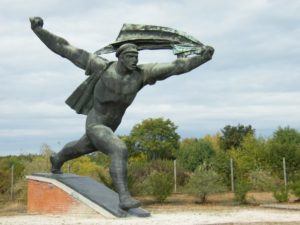 This fascinating museum park in the outskirts of Budapest is dedicated to the numerous Communist monuments and statues which used to stand around the city.
This fascinating museum park in the outskirts of Budapest is dedicated to the numerous Communist monuments and statues which used to stand around the city.
Many of these statues were brought down by the general public after the Communist Regime fell in 1989, or were removed and put in storage, as nobody knew what to do with them.
The park was opened in 1993, as a way to showcase these statues as an important part of the history of the country.As well as the statues, there is a small museum, which includes information about life under the communist regime.
The Buda Hills
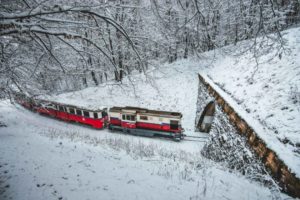 The Buda Hills, which lie in the western half of the city, are some of the greenest, cleanest areas of the city.You will find numerous biking and hiking trails to follow, which all have an easy-to-medium difficulty level.Alternatively take the Children’s Railway, which is (almost) entirely staffed by children aged 10-14. Travelling to the highest point in the hills will give you a great view across the city, and will give you the opportunity to see things from a different perspective.
The Buda Hills, which lie in the western half of the city, are some of the greenest, cleanest areas of the city.You will find numerous biking and hiking trails to follow, which all have an easy-to-medium difficulty level.Alternatively take the Children’s Railway, which is (almost) entirely staffed by children aged 10-14. Travelling to the highest point in the hills will give you a great view across the city, and will give you the opportunity to see things from a different perspective.
Central Market Hall
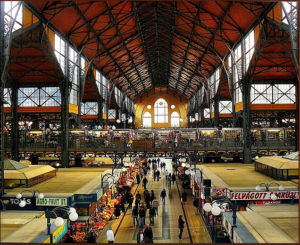 The Central Market Hall or Great Market Hall is the most beautiful Budapest market hall. It was built in 1897 with beautiful tiled roofs and a colourful facade of patterned orange bricks. Although the Central Market Hall (Vasarcsarnok) was pretty damaged during WW2, it has been restored perfectly in the 1990s. “Budapest’s biggest indoor market is the sort of place where you can wander for hours, until sensory overload kicks in.Though it’s a popular tourist stop—and there are a raft of stalls selling Hungarian dolls, embroidered linens, glassware, and other souvenirs—plenty of locals do their regular food shopping here as well.” (Frommer’s travel guide) That’s true, Hungarians buy their daily fruit-vegetable intake here too (although penny-pinching Hungarians would go to Lehel ter Market Hall).
The Central Market Hall or Great Market Hall is the most beautiful Budapest market hall. It was built in 1897 with beautiful tiled roofs and a colourful facade of patterned orange bricks. Although the Central Market Hall (Vasarcsarnok) was pretty damaged during WW2, it has been restored perfectly in the 1990s. “Budapest’s biggest indoor market is the sort of place where you can wander for hours, until sensory overload kicks in.Though it’s a popular tourist stop—and there are a raft of stalls selling Hungarian dolls, embroidered linens, glassware, and other souvenirs—plenty of locals do their regular food shopping here as well.” (Frommer’s travel guide) That’s true, Hungarians buy their daily fruit-vegetable intake here too (although penny-pinching Hungarians would go to Lehel ter Market Hall).
Go on a Pub Crawl of Budapest’s Ruin Bars
Indulge on Pastries From Budapest’s Oldest Confectioner
*If you have already filled up an application form on our website for any other trip ever before, then you don’t need to fill up the form again, just email [email protected]
FAQ:
Ans. Europe is safe and Romania is a very safe country. It is ranked 30th out of 162 on the ranking of the safest and most dangerous countries.
Q. How to apply for visa and what is the cost.
Ans. Approx. 4500 (as per VFS website)
check this link: Romania VISA
Q. Can I drive ?
Ans. Yes, you can but you should have IDP(International driving permit)
Q. Can I see pictures from your earlier trips?
Ans. Yes, click on this LINK
Q. What kind of hotels we will be staying?
Ans. We will be staying best hotels in the city center, if you need the names of the properties then email us on [email protected] and check the reviews. We always provide best hotel experience to our customers.
Thanks
Gaurav Rana
Team TBT
9029099709
www.travelbuddiestalk.com


